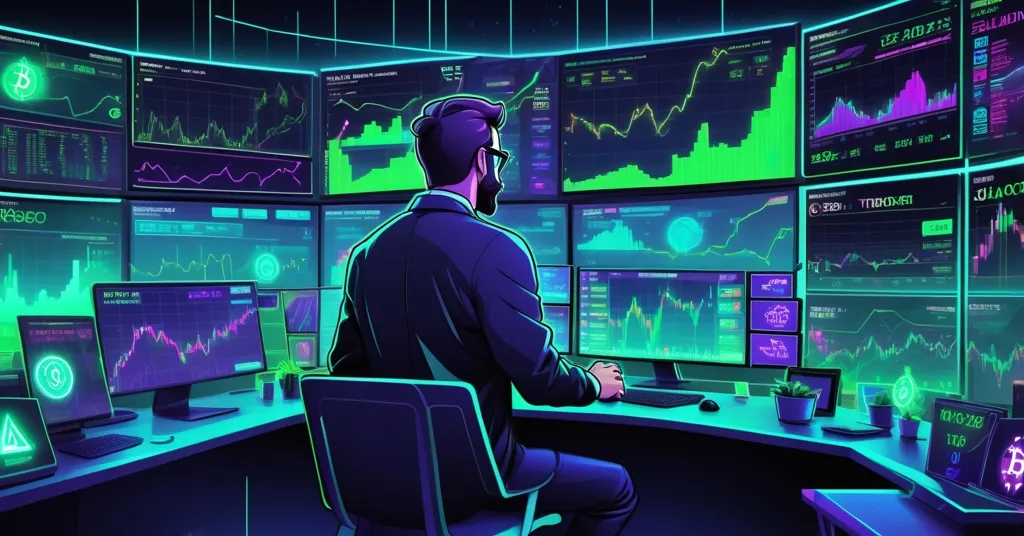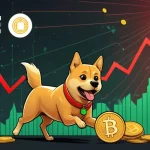gTrade v10 Update Unleashes Tools for Pro Crypto Traders on Decentralized Exchanges

gTrade v10 Update: Powering Pro Crypto Traders on Decentralized Exchanges
Gains Network has unleashed the v10 update for gTrade, its decentralized perpetual exchange, delivering a robust suite of tools tailored for high-leverage trading across crypto and traditional markets. This isn’t a mere patch—it’s a bold leap aimed at professional traders and integrators, promising scalability and precision in the competitive DeFi arena.
- Advanced Trading Tools: gTrade v10 rolls out a new funding fee mechanism for scalability and enhanced user experience.
- Pro Trader Focus: Targets swing traders, arbitrageurs, market makers, and ecosystem integrators.
- Massive Incentive: A $200,000 trading competition in August to boost engagement across multiple networks.
Revamped Funding Fees: Tackling Scalability Head-On
The heart of the v10 update lies in its overhauled funding fee mechanism, a market-driven model replacing the outdated borrowing fee system for major crypto markets like Bitcoin (BTC), Ethereum (ETH), Solana (SOL), XRP, and Binance Coin (BNB). For those unfamiliar, funding fees are periodic payments between long and short position holders to balance market skew—an imbalance where too many traders are betting on price increases (longs) or decreases (shorts). When longs dominate, they pay shorts to incentivize rebalancing, and vice versa. This shift isn’t just technical jargon; it’s a direct assault on scalability bottlenecks, designed to minimize the risk of hitting open interest caps that throttle trading on many decentralized exchanges (DEXs). If you’re curious about the broader concept of funding fees in decentralized finance, it’s worth exploring further. Compared to competitors like dYdX, which uses dynamic funding rates, or GMX, with its focus on liquidity pools, gTrade’s model prioritizes real-time market dynamics for smoother fee adjustments.
However, there’s a catch—this new system applies only to positions backed by stablecoin collateral. If you’re using GNS (Gains Network’s native token), ETH, or APE as collateral, you’re stuck with the old borrowing fee structure for now. This partial rollout risks confusing users expecting uniformity, and it’s a point of friction gTrade must address. Scalability wins are promising, but DeFi history—like the 2021 liquidations on leveraged platforms during market crashes—reminds us that fee model tweaks can backfire if not paired with robust risk management. Will gTrade’s approach hold up under stress? Only time and volatile markets will tell.
Expanded Markets: Bridging Crypto and Traditional Finance
gTrade isn’t stopping at crypto. The v10 update opens access to over 240 digital currencies while integrating traditional markets like tech stocks, forex pairs, commodities, indices, and precious metals. This means you can short a Silicon Valley giant while going long on BTC with up to 100x leverage—all from a decentralized platform. It’s a powerful draw for traders seeking cross-asset strategies, and it aligns with DeFi’s broader mission to merge conventional finance with blockchain innovation. For Bitcoin maximalists like myself, seeing BTC trading pairs get premium treatment is a win, but I can’t deny the value altcoins and traditional assets bring in onboarding diverse users who might eventually see Bitcoin as the ultimate store of value. For more on the specifics of this update, check out the gTrade v10 rollout for pro traders.
Yet, blending these markets isn’t without hurdles. Liquidity fragmentation across asset classes can strain DEXs, and regulatory scrutiny on leveraged trading—especially for traditional assets—looms large. DeFi platforms dabbling in stocks or forex might attract the wrong kind of attention from regulators already skeptical of crypto’s wild west. gTrade’s ambition is commendable, but it’s walking a tightrope between innovation and potential crackdowns.
Under-the-Hood Features: Tools for the Trading Elite
Diving deeper, gTrade v10 packs features that cater to seasoned traders. Take “Counter Trades,” a clever mechanism offering lower fees and better execution for trades that correct market skew. Imagine being rewarded for stabilizing a lopsided market—low-leverage trades that balance longs and shorts get a discount. Then there’s “PnL Withdrawals,” letting traders pull profits mid-position without closing their trade. Think of it as cashing out part of your winnings at a poker table without leaving the game—a game-changer for managing capital on the fly. Additionally, the new “Market Price” execution reflects real-time demand and skew, moving beyond static oracle data (though liquidations still rely on oracles for fairness), ensuring trades align with actual market conditions. For a deeper dive into the features, the detailed breakdown of gTrade v10 mechanics is a must-read.
These tools scream sophistication, but they’re not newbie-friendly. The complexity could alienate retail traders—a core demographic for DeFi’s growth. gTrade’s pivot to pros like swing traders, arbitrageurs, and market makers is strategic, but will it sacrifice accessibility? Playing devil’s advocate, focusing on the elite risks building a walled garden, potentially stunting broader adoption in a space that thrives on inclusivity.
Competition and Challenges: Where gTrade Stands in DeFi
In the cutthroat world of DeFi perpetuals, gTrade faces stiff competition from heavyweights like dYdX, which boasts advanced order books and funding rate models, and GMX, known for its deep liquidity pools. gTrade’s edge lies in its aggressive push into traditional markets and scalability focus, carving a unique niche. Its reported lifetime trading volume of $100 billion and $60 million in revenue—if accurate—signal serious staying power. However, these stats remain unverified without on-chain data from tools like Dune Analytics, and I’d urge skepticism until confirmed. Transparency matters, especially in a space rife with inflated claims. For a broader look at how gTrade’s funding model stacks up, this comparison of perpetual exchange funding mechanisms offers valuable context.
Beyond competition, risks abound. High-leverage trading, while lucrative, invites manipulation—think whales skewing markets to trigger liquidations, a tactic seen in past DeFi meltdowns during volatile swings. Regulatory heat on leveraged products, especially cross-asset offerings, could also clip gTrade’s wings. And let’s not ignore sustainability concerns—while networks like Arbitrum and Solana (where gTrade operates) are more energy-efficient than Bitcoin’s proof-of-work, the carbon footprint of high-frequency trading still sparks debate among eco-conscious crypto heads. gTrade’s innovations are exciting, but they’re not immune to systemic challenges.
Incentives and Tokenomics: Fueling Growth and Engagement
To drive adoption, gTrade is hosting a $200,000 trading competition in late August across Arbitrum, Base, Solana, and Polygon networks. While specifics like eligibility and reward breakdowns are still pending, it’s a savvy move to spike user engagement during a critical rollout phase. Historically, such events pump trading volume, but they can also attract wash trading or bots—something to watch for. If you’re interested in community feedback on this update, there’s an active discussion on gTrade’s funding fees and v10 features worth checking out.
On the tokenomics front, v10 ties into strengthening the deflationary model of the GNS token. Higher trading volumes and revenue are meant to fuel buybacks and burns, reducing supply and potentially boosting value. It’s a neat alignment of platform success with holder interests, but don’t get dazzled—deflationary tricks mean little if adoption falters or market sentiment tanks. Token value is never a sure bet in this volatile game. For a comprehensive take on the update’s impact, this review of Gains Network’s gTrade v10 provides additional insights.
Critical Insights for Crypto Traders
- What’s the main thrust of the gTrade v10 update?
It’s all about enhancing high-leverage trading for crypto and traditional markets with a new funding fee model to improve scalability and user experience. - Who benefits most from these new tools?
Professional traders—swing traders, arbitrageurs, market makers—and integrators like Volmex Finance, Bifrost, and Symphony building on gTrade’s platform. - What are the potential pitfalls to consider?
Complexity in funding fees and partial rollout for stablecoin collateral might confuse users, while high-leverage environments risk market manipulation. - How does gTrade compare to other perpetual DEXs?
Its focus on traditional market access and scalability sets it apart, though it battles giants like dYdX and GMX for user base and feature dominance. - Should traders join the $200,000 competition?
If you’re active on Arbitrum, Base, Solana, or Polygon, it’s a great opportunity to test v10 features and earn rewards, pending full details. - Does gTrade v10 align with decentralization goals?
Mostly yes, with trustless execution and on-chain transparency, though reliance on oracles for liquidations introduces a minor centralized touchpoint worth critiquing.
gTrade’s Vision: Accelerating DeFi’s Future
As gTrade v10 pushes the boundaries of what a decentralized perpetual exchange can achieve, it embodies a spirit of effective accelerationism—rapidly advancing DeFi infrastructure to disrupt centralized finance faster than anticipated. Seb, the visionary founder of gTrade, captures this ambition perfectly:
“gTrade v10 is an expansion of what’s always made the platform special. We’re taking the precision and transparency that scalpers loved and unlocking it for a broader class of traders, integrators, and funding fee farmers. It’s a very important step toward making gTrade the most efficient, accessible, and scalable Perp DEX in DeFi.”
From a Bitcoin-maximalist lens, I’m stoked to see BTC trading pairs optimized with ultra-high leverage, reinforcing its role as crypto’s cornerstone. Yet, the inclusion of altcoins and traditional assets is a pragmatic nod to ecosystem diversity—broadening DeFi’s appeal often loops back to Bitcoin as the ultimate safe haven. The real test for gTrade will be balancing bleeding-edge innovation with accessibility. If they can nail scalability without leaving retail traders behind, they’re poised to redefine DeFi perpetuals. For now, whether you’re a curious newbie or a battle-hardened whale, gTrade’s latest move is a signal of where decentralized trading is headed—full speed ahead, with a few potholes to dodge. Do your homework, trade smart, and keep an eye on how this unfolds.



